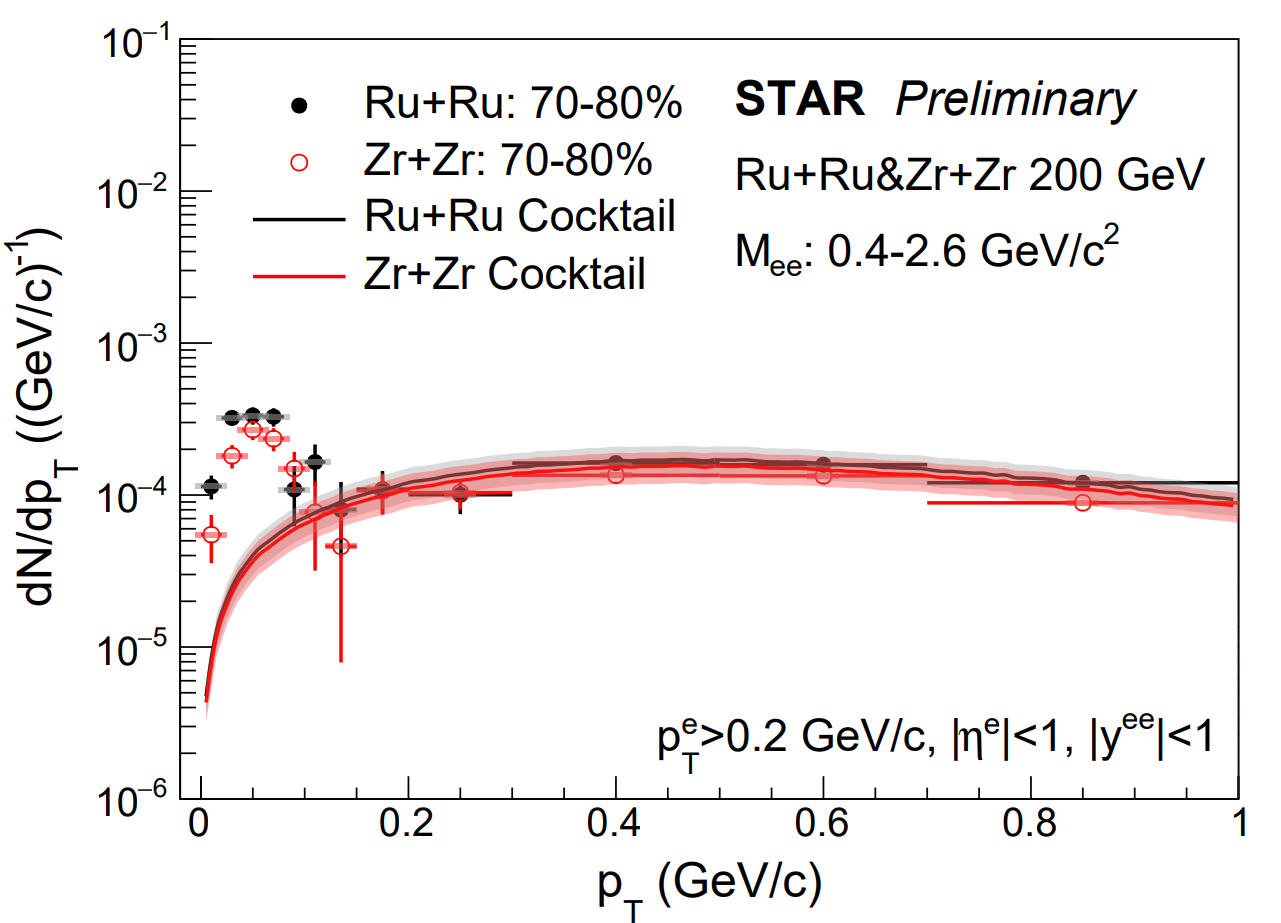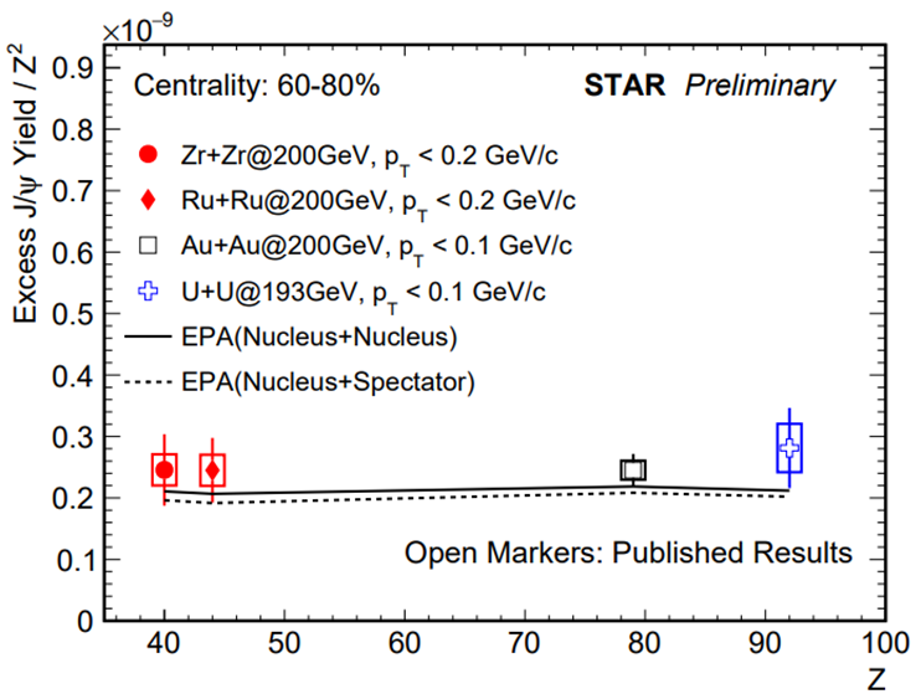Initial electromagnetic field dependence of photon-induced production in isobaric collisions at STAR
Initial electromagnetic field dependence of photon-induced production in isobaric collisions at STAR
PAs:
Target Journal:
Abstract:
We present the measurements of e+e- pair production at very low transverse momentum (pT) in Ru+Ru and Zr+Zr collisions at √sNN = 200 GeV by the STAR experiment. The electromagnetic field dependence of photon-induced production is studied for the first time, via comparisons between the measurements in isobaric collisions to the published results in Au+Au and U+U collisions. Taken the initial electromagnetic field dependence into account, the excess yield of e+e- pair production shows an impact parameter dependence. The results are also compared to model calculations based on EPA-QED, which describe the observed excess yields for different collision species.
Figures:
|
|
| Figure 1. (a) The e+e- invariant mass spectra within the STAR acceptance from Ru+Ru and Zr+Zr collisions for pair pT < 0.15 GeV/c in 70-80% centrality. The hadronic cocktails are shown as solid lines of different color. (b) The corresponding ratios of data over cocktail. The shaded bands on the data points indicate the uncertainties from the systematic uncertainties. |
|
|
| Figure 2. The e+e- pair pT distribution within the STAR acceptance from Ru+Ru and Zr+Zr collisions for pair 0.4 GeV/c2 < Mee < 2.6 GeV/c2 in 70-80% centrality. The hadronic cocktails are shown as solid lines of different color. The shaded bands on the data points indicate the uncertainties from the systematic uncertainties. |
|
|
| Figure 3. The centrality dependence of integrated excess yield at pair pT < 0.1 GeV/c in the mass region of 0.4-2.6 GeV/c2 in Ru+Ru and Zr+Zr collisions within the STAR acceptance (up plane). The centrality dependence of the ratio of integrated low-pT excesses between Ru+Ru and Zr+Zr collisions at pair pT < 0.1 GeV/c in the mass region of 0.4-2.6 GeV/c2 within the STAR acceptance (bottom plane), The solid line is the fitted result to data points by a constant function. The boxes on the data points indicate the uncertainties from the systematic uncertainties. |
|
|
| Figure 5. The pT dependence of e+e- yield ratios between Ru+Ru and Zr+Zr collisions in the mass region of 0.4-2.6 GeV/c2 within the STAR acceptance. The error bars represent the statistical and systematic uncertainties. |
|
|
| Figure 6. The collision system dependence of the integrated e+e- excess yield within the STAR acceptance, scaled with Z4, in 70-80% centrality. The error bars represent the statistical uncertainties, and the boxes are systematic uncertainties. The dash line is the EPA-QED prediction. |
|
|
| Figure 7. The collision system dependence of the integrated Jpsi excess yield, scaled with Z2, in 60-80% centrality. The error bars represent the statistical uncertainties, and the boxes are systematic uncertainties. The dash line and solid line are two the EPA predictions. |
|
|
| Figure 8. The delta phi distribution of e+e- in 60-80% centrality. The error bars represent the statistical uncertainties. The blue line is the EPA-QED prediction, and the red line is the fitted result. |
Summary:
In summary, we report on enhancements of e+e- and J/psi production at very low pT in peripheral isobaric collisions at √sNN = 200 GeV within the STAR acceptance at RHIC.
- The initial EM field seems to be different in peripheral Ru+Ru and Zr+Zr collisions
- The excess yield of e+e- as function of Z shows an impact parameter dependence after charge difference scaled
- The excess yield of J/psi as function of Z is mostly independent of collision system
- The cos(4delta phi) signal is prominent (~3.6 sigma) in isobaric collisions and no significant different is observed between isobaric and Au+Au collisions
Related presentations:
Here is a summary of links about related presentations on pwg meeting.
- https://drupal.star.bnl.gov/STAR/system/files/Isobar_unblind_RuRu_20210621_v3_0.pdf
- https://drupal.star.bnl.gov/STAR/system/files/preliminary_result_dielectron_sqm_2022_0.pdf
- https://drupal.star.bnl.gov/STAR/system/files/Isobar_unblind_kaifeng.pdf
- https://drupal.star.bnl.gov/STAR/system/files/collaboration_meeting_202302_v1_0.pdf
- https://drupal.star.bnl.gov/STAR/system/files/Isobar_unblind_Ru_Zr_v5.pdf
- https://drupal.star.bnl.gov/STAR/system/files/collaboration_meeting_v2.pdf
- https://drupal.star.bnl.gov/STAR/system/files/collaboration_meeting_202209_v2.pdf
- kshen's blog
- Login or register to post comments



.png)
.png)


